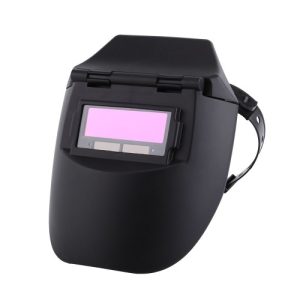Welding Gloves
Gloves are pretty self-explanatory. Welding gloves consist of layers of robust fabrics and insulation, preventing injuries from heat and stray sparks. Welding gloves are easy to find anywhere you buy gloves, but they are essential to any form of welding you might do.
There are usually 2 types you need to be aware of:
• MIG Welding Gloves – These are generally thicker and have padding on the back of the hand to protect your resting hand while bracing the dominant hand during a weld. If the glove becomes too hot, the looser fitting design allows you to throw them off easily.
• TIG Welding Gloves – These are thinner and softer gloves where precision is vital. Dexterity is key when TIG welding and the gloves will have a tighter fit to allow precise movement while holding the rod and torch.
Auto-Darkening Welding Helmet
The primary purpose of any type of welding helmet is to prevent sparks and flames from scarring your face while you work and prevent damage to the skin and eyes from the heat.
Not all welding helmets are created equal, but you don’t have to spend $350 to get a good one.
The first piece of advice we would give you here is to choose an auto-darkening welding helmet.
A welding helmet is the most important welding workshop tool you have, so you want something that’s user-friendly.
Your other option is to buy a welding helmet that has a solid shade, but here’s the problem with that. You can’t see your workpiece through the lens, and it could cause your welds to be placed improperly.
Auto-darkening welding helmets are great welding tools for beginners because they allow you to easily see the workpiece before starting your welds, which means more accuracy and less frustration.
MIG Welding Pliers
MIG pliers are widely available in most hardware stores as well as online. They are far from a specialty item and are pretty cheap for how much you can do with them.
They have several uses which include:
• Removing the nozzle from the MIG gun – They come equipped with circular clamps, perfect for removing nozzles from the MIG gun.
• Loosen & tighten the contact tip – This is something you’ll have to do regularly as it gets worn out.
• Cut 1/4″ Stick-Out – Saves you time instead of using a separate wire cutter.
• Remove Weld Spatter – Cleaning the inside of the nozzle from the spatter is easier with the tips of the pliers.
Metal File
Similar to the angular grinder, the metal file’s primary use is to remove rough edges and burrs from the metal that you cut.
Metal files are also commonly used for all kinds of other metalworking projects; you have probably used them before at some point.
While angular grinders are good at the rougher removal process, files are for finishing and making a project look nice.
Welding Magnets
Welding magnets are an essential welding fabrication tool because they are so versatile.
You can easily hold pieces in place, and create 90-degree angles with any of your projects. They’re great when you’re building welding frames for tables, fire pit grates, and more.
They come in several different sizes for small welding projects all the way up to large projects. But make sure you buy multiple magnets.
If you’re making a square frame, you’ll want to have 1 magnet on each corner of the workpiece holding it in place.
These are just the basics, there are so many more tools that you probably haven’t even heard of in order to be successful in welding. Contact Nu-Tech today, we’ll sort you out in no time.